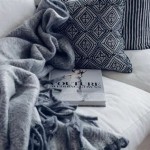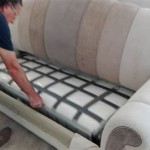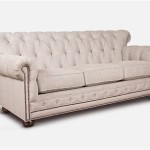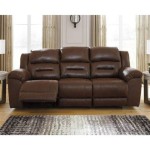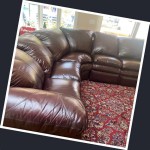DIY No-Sew Sofa Slipcovers
Updating a living room aesthetic often involves significant expense. However, reupholstering or replacing a sofa can be costly. A no-sew slipcover offers an economical and convenient alternative for refreshing a sofa's appearance and protecting it from wear and tear. This approach allows for easy customization and changes without the commitment of permanent alterations. With readily available materials and simple techniques, creating a no-sew slipcover is a manageable project for most individuals.
Choosing the Right Fabric
Fabric selection plays a crucial role in the overall look and feel of the slipcover. Durability, comfort, and aesthetics should be primary considerations. Heavy-duty fabrics like denim, canvas, or twill offer durability and structure. Lighter fabrics like cotton or linen provide a more relaxed feel but might require more frequent washing. The color and pattern of the fabric should complement the existing décor of the room.
When calculating fabric needs, it is advisable to measure the sofa thoroughly, adding extra inches for tucking and adjustments. The required yardage depends on the sofa size and the fabric width. Consulting online fabric calculators can assist in determining the precise amount needed. Testing fabric swatches for colorfastness and shrinkage before purchasing the full amount prevents potential disappointment later.
Essential Tools and Materials
Creating a no-sew slipcover doesn’t require specialized equipment. Common household items can be utilized effectively. These items typically include: measuring tape, scissors, fabric markers, pins, and upholstery tacks or safety pins. A drop cloth or old sheet can be helpful to protect the sofa during the process. Tucking tools, like a ruler or wooden dowel, assist in smoothing the fabric and creating clean lines.
While no sewing machine is required for this project, having fabric glue on hand can be beneficial for securing folded edges or reinforcing seams, especially in high-traffic areas. Fabric adhesive tape can also be used as an alternative to glue for a quick and easy option. Iron-on fusible bonding web can be useful for creating hems or adding decorative elements.
Step-by-Step Slipcover Creation
Begin by draping the chosen fabric over the sofa, ensuring even coverage. The wrong side of the fabric should face outwards for easy pinning and tucking. Working systematically, from the top down, start smoothing out the fabric and tucking it into the crevices of the sofa. Use pins to secure the fabric in place, ensuring a snug fit. Pay close attention to areas like the arms, back, and seat cushions.
For areas requiring a more tailored appearance, such as the arms and back, excess fabric can be folded and tucked in to create clean lines, securing folds with pins. A ruler or wooden dowel can assist in pushing the fabric deep into the crevices for a seamless look. Once satisfied with the fit, the pins can be replaced with upholstery tacks for a more permanent hold or with safety pins for a less intrusive solution.
Maintaining Your No-Sew Slipcover
The ease of care for a no-sew slipcover is a major benefit. Most fabrics can be removed and laundered according to the manufacturer's instructions. Periodically, the slipcover should be inspected for any loose tacks or pins and addressed promptly to prevent further damage to the fabric or sofa. Frequent vacuuming also helps maintain the slipcover’s appearance and extends its lifespan.
Depending on the fabric choice and usage, some wrinkles may occur after washing. These can typically be smoothed out by hand or with a handheld steamer. Ironing might be necessary for certain fabrics, but always check the fabric care instructions beforehand to avoid scorching or melting. Storing the slipcover properly when not in use helps preserve its shape and color.
Customizing Your Slipcover
Once the basic slipcover is complete, various customization options can enhance its visual appeal. Adding decorative elements like ribbons, tassels, or fabric flowers can personalize the slipcover. For a more layered look, consider draping a throw blanket over the back or adding decorative pillows that complement the fabric. These additions can create a more polished and stylish finish.
Further customization can be achieved by using contrasting fabrics for different sections of the slipcover, like the arms or cushions. This can add visual interest and create a unique piece. Experimenting with different textures and patterns can transform the look of the sofa and the entire living space. This allows for adaptable design changes without the commitment of permanent modifications.
:max_bytes(150000):strip_icc()/9CraftingNook-499f3378b698461cb206f172f76a9286.jpg?strip=all)
20 Diy Couch Cover Ideas For Any Budget

No Sew Drop Cloth Slipcover Town Country Living

Diy Couch Cover Ideas Easy Sofa Slipcovers You Can Make O Sewing

No Sew Drop Cloth Slipcover Town Country Living

How To Make A Sectional Slipcover Confessions Of Serial Do It Yourselfer

Couch Cover Using Drop Cloth No Sewing

5 Steps In Turning A Sheet Into Couch Cover No Sewing Diy Sofa

Simple Sofa Slipcover Confessions Of A Serial Do It Yourselfer

No Sew Drop Cloth Slipcover Town Country Living

Diy Sofa Slipcover Update Refresh Renew The Crafting Nook
Related Posts

